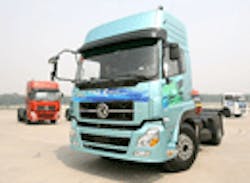A new analysis of China’s commercial truck market finds that demand for heavier chassis and cleaner diesel engines will spike over the next five years, offering potentially big revenue-generating opportunities for U.S. and European truck makers. And that positive result could also benefit U.S. truck fleets by lowering the cost of emission control technologies.
According to the report due out next week from research firm Frost & Sullivan titled “Strategic Analysis of the Chinese Commercial Vehicle Market,” that country’s commercial truck production is projected to expand from 1.92 million units in 2008 to over 2.68 million units by 2015 – resulting in a compound annual growth rate of 4.9%. That growth is being driven by several factors, including new roadway weight limit rules, increased fuel taxes, and the harmonization of China’s truck emission statutes with those of the U.S. and Europe, said the report.
The end result, noted Sandeep Kar, program manager &senior industry analyst with Frost & Sullivan’s North American automotive & transportation practice, is that China’s truck manufacturers are increasingly looking to forge partnerships with U.S. and European truck OEMs to gain design expertise in fuel economy and emission control systems.
By extension, Kar told FleetOwner, economies of scale gained from such joint ventures could lower the global cost of producing emission control system components-- possibly leading to price reductions for such system from U.S. and European truck markets.
“How do OEMs get economies of scale today? They can’t in their local markets – truck [sales] volumes are low in Europe and the U.S.,” he explained. “So you must take your technology abroad to markets that are growing. That not only gives you economies of scale but a way to test out technology as well; all while helping top and bottom line revenue look better and better.”
Kar said Chinese demand for heavy trucks – those with gross vehicle weights of 14 tons or more – will climb due to several factors. The first is new “charge-by-weight” laws that severely penalized overloaded vehicles . These rules should force many Chinese truck owners to upgrade from medium trucks (with GVWs of six to 14 tons) to heavier models capable of legally hauling heavier loads. The second is a boost in diesel fuel taxes from 1 cent to 11 cents per liter. That move will drive demand for more fuel -efficient engines, Kar said. Finally, the harmonization of Chinese truck emission rules with those of the U.S. and Europe – expected to occur in stages between 2010 and 2012 – will boost demand for emission control systems.
All of this will help drive yearly heavy truck sales to levels far in excess of North America volumes, Kar noted. “Right now, the North American Class 8 market is hovering between sales of 100,000 and 150,000 annually,” said Kar. “Chinese heavy-truck demand will be in the range of 500,000 units annually; more than five times the volumes currently seen in North America.”
The benefit for U.S. fleets is that higher adoption rates of emission control systems in China could help lower the cost of similar technology for them. “It’s about leveraging the sales volume of China and other growing truck markets, like Russia and India, to drive the overall cost of emission technology down,” he said.
About the Author
Sean Kilcarr
Editor in Chief
Sean Kilcarr is a former longtime FleetOwner senior editor who wrote for the publication from 2000 to 2018. He served as editor-in-chief from 2017 to 2018.
